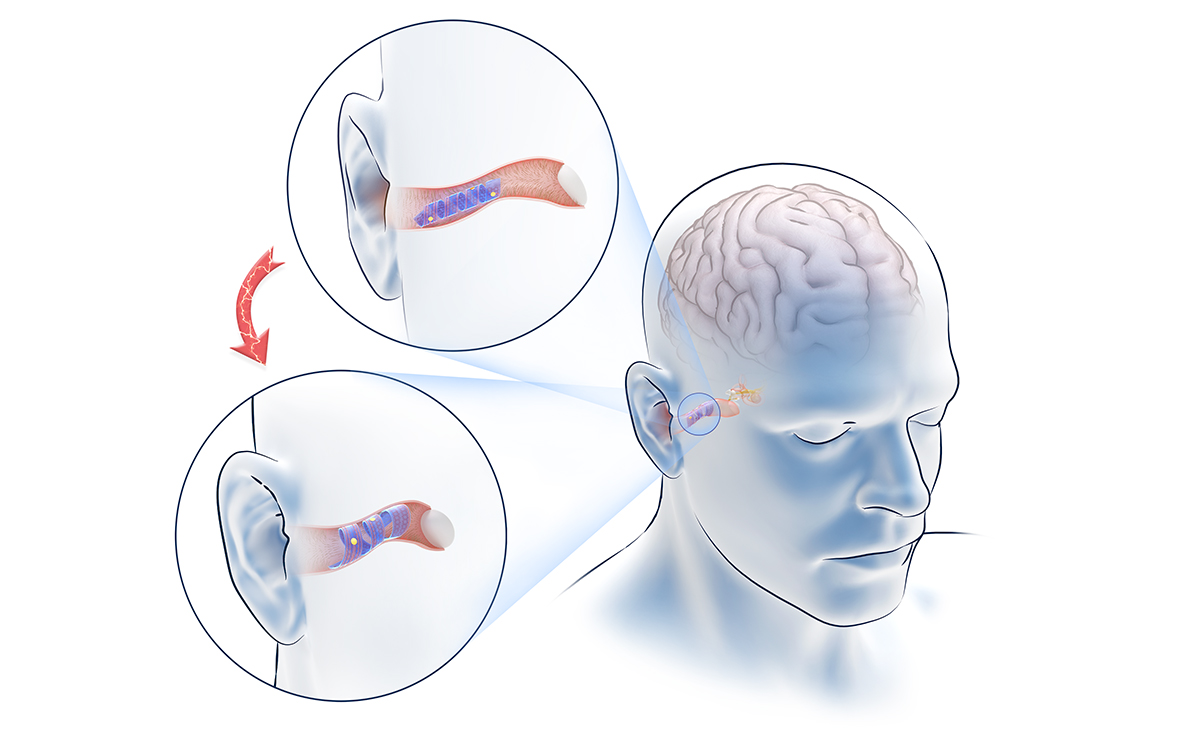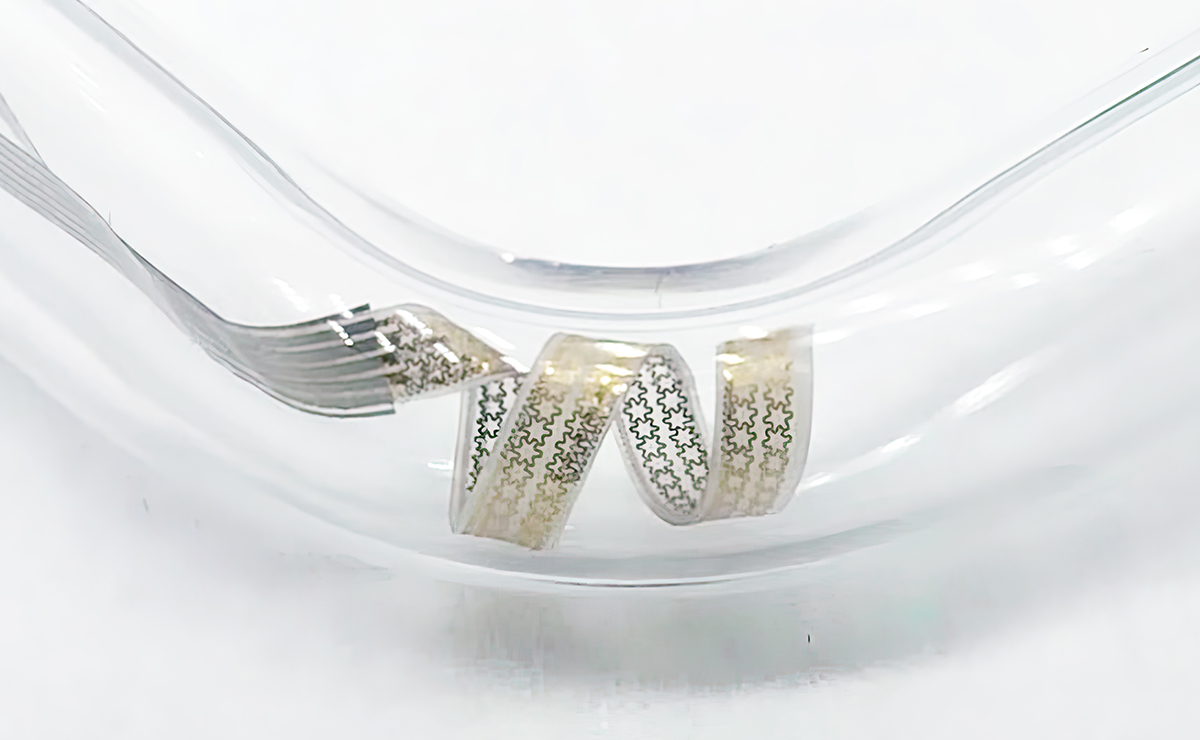A non-invasive piece of tech placed into the ear brings wearable brain-computer interface technology closer to everyday use.
A compact electronic device worn discreetly behind or slipped into the ear could soon help monitor the wearer’s brain activity or even deliver brain stimulation. This new type of brain-computer interface (BCI) is far more comfortable and less conspicuous than the traditional electrode arrays placed across, or even inserted in the scalp.

A Tsinghua designed brain-computer interface inserted into the ear could soon help monitor a wearer’s brain activity.
Brain-computer interfaces are progressing rapidly, says Xiaorong Gao of Tsinghua University’s School of Medicine, China, a lead author of a paper published in Nature Communications describing the ‘SpiralE’ in-ear BCI.1 In the field of medical rehabilitation, for example, BCIs have already allowed those with paralysis to regain partial motor function with the help of robotic prosthetics.
But new developments that allow for the interpretation of increasingly intricate brain activity are rapidly expanding BCI’s potential, Gao says. For example, in people with diseases affecting motor nerve cell function, such as amyotrophic lateral sclerosis (ALS), BCIs are increasingly able to decode motor intentions involved in writing or speech so that they can be mimicked by computer aids. Another development is the design of comfortable interfaces that are non-invasive and painless to wear, such as Gao’s work.
Discreet design
Gao was inspired to develop his in-ear BCI device following a foundational 2015 study he led demonstrating the rapidly evolving power of brain activity tracking technology.2 The study pioneered a high-speed BCI, called a state visual evoked potential (SSVEP) BCI, in which participants would ‘type’ words by directing their gaze in different directions to select characters of the alphabet.
The BCI detected and understood gaze so fast that it allowed subjects to communicate in real-time, at the speed of a person typing on a keyboard. This result markedly surpassed the speed of other options at the time, setting a new standard for non-invasive BCIs. “This motivated us to take this technology from a lab setting and to use it in real-life settings,” says Gao.
Conventional BCIs designed to monitor electrical activity in the brain via technology called electroencephalography (EEG) have typically followed one of two designs. They either featured electrodes surgically implanted under the scalp, or — as with Gao’s visual typing study — electrodes worn across the outside of the scalp as an ‘EEG cap’. Gao’s in-ear BCIs are designed to be far more comfortable, convenient and discreet for use outside of the lab. “Our in-ear BCIs are the result of refining the interface to strike a balance between recording quality and comfort,” says Gao.
But as the shape of the ear canal is unique to each person, Gao faced significant challenges in designing devices that fit comfortably, while maintaining good contact with the inner wall of the ear canal for EEG recording. “Designing SpiralE was tricky because seldom have in-ear devices achieved a balance between comfort and signal quality,” he says.

A Tsinghua designed device called SpiralE expands and deforms to maintain contact with ear canal walls to enable less invasive readings of electrical impulses from the brain.
Valuable tool
Using soft electronics, the team designed SpiralE to fit in anyone’s ear by creating a flexible, narrow corkscrew EEG reader; once inserted into the ear canal, gentle heating expands the device, helping form a tight contact with the ear canal inner wall. Because the inside is hollow, SpiralE lets sound through to maintain normal hearing.
“We consulted medical experts and repeated rigorous tests to ensure that it was safe to insert the device,” Gao adds. The team has demonstrated that the device worked well for recording brain activity including responses to visual and auditory stimuli.
These advances, coupled with electronic brain stimulation techniques, could also transform BCIs from passive recording devices of neural signals to potentially active players in tracking and addressing the symptoms of neurological and psychological disorders, including severe depression, Gao says.
“BCIs may also soon become valuable day-to-day tools, for example, with helping users monitor sleep quality and attention levels, or detecting drowsiness,” he adds. “BCIs in the ear have shown promise in areas like seizure detection and sleep monitoring, and SpiralE holds the potential to significantly enhance these applications.”
He is now working with several other research teams developing BCIs placed in or around the ear in innovative ways, particularly for BCIs that involve vision.3 In a 2023 study led by collaborators from the University of Chinese Academy of Sciences, Gao and his colleagues reported their creation of an earpiece made of hydrogel.
The new earpiece eliminated the need for wet electrodes, which required extensive participant preparation before use, including removing hair and grinding the outermost skin layer. They also showed that placing devices in the region behind the ear canal is better for visual information decoding, compared to ear canal placement.
The hydrogel earpiece adds to a 2021 study led by Liyan Liang of Tsinghua University’s School of Medicine, in which Gao participated, which explored different ways of stimulating the brain’s vision centres.4 The team showed that optimizing brain stimulation for electrode placement in the hairless area behind the ear made the BCI faster and more accurate. The combination of these insights may inspire vision-related BCI that is wearable, comfortable, and discreet.
Commercial potential
Gao’s ultimate BCI vision is to integrate brain activity recording and stimulation into a single device, culminating in the development of what he calls a bi-directional closed-loop BCI system. This would also allow two-way communication between the brain and external devices. It would also capture real-time brain data and provide feedback to the user, so that a person with a prosthetic hand, for example, could not only pick up a glass, but ‘feel’ the glass in their hand. “This could help restore brain functions that were compromised, or even augmenting certain capabilities,” Gao says.
In addition to the technological improvements, Gao believes BCIs placed in or around the ear have vast commercial potential.
“Their commercial viability is evident through the tremendous investment that start-up companies delving into this technology are receiving,” says Gao. “Tech giants like Apple and Samsung have also ventured into this space, filing patents for EEG sensor technology to use in their earbuds. These circumstances indicate that BCIs in or around the ear may be the technology that finally makes BCI technology commonplace.”
References
1. Wang, Z., Shi, N., Zhang, Y., Zheng, N., Li, H. et al. Conformal in-ear bioelectronics for visual and auditory brain-computer interfaces Nature Communications 14, 4213 (2023) doi: 10.1038/s41467-023-39814-6
2. Chen, X., Wang Y., Nakanishi, M., Gao, X., Jung, T.-P. & Gao, S. High-speed spelling with a noninvasive brain–computer interface Proceedings of the National Academy of Sciences 112, E6058 (2015) doi: 10.1073/pnas.1508080112
3. Zhao, H., Zheng, L., Yuan, M., Wang, Y., Gao, X. et al. Optimization of ear electrodes for SSVEP-based BCI Journal of Neural Engineering 20, 046011 (2023) doi: 10.1088/1741-2552/acdf85
4. Liang, L., Bin, G., Chen, X., Wang, Y., Gao, S. & Gao, X. Optimizing a left and right visual field biphasic stimulation paradigm for SSVEP-based BCIs with hairless region behind the ear Journal of Neural Engineering 18, 066040 (2021) doi: 10.1088/1741-2552/ac40a1
Editor: Guo Lili